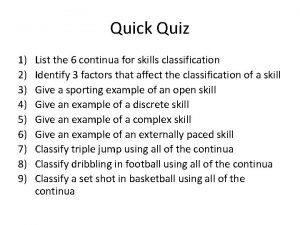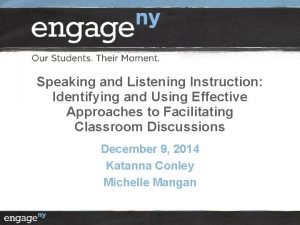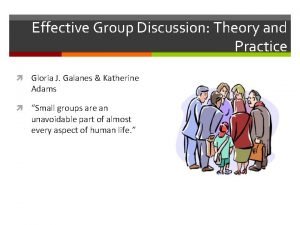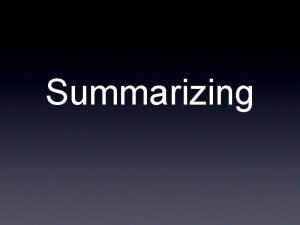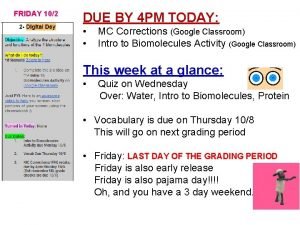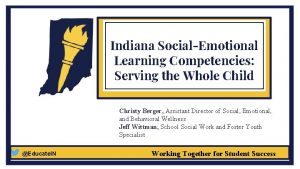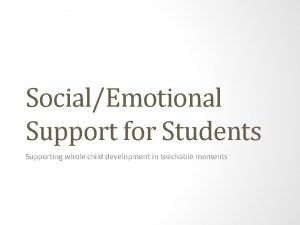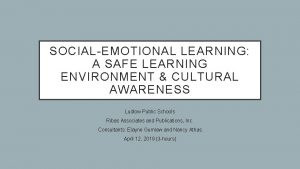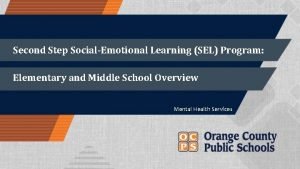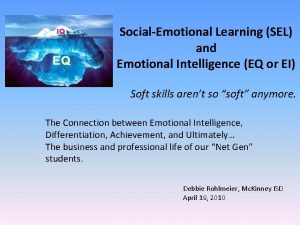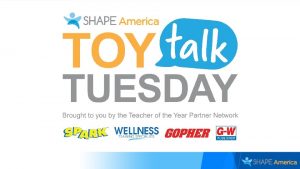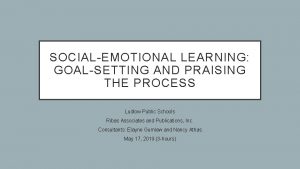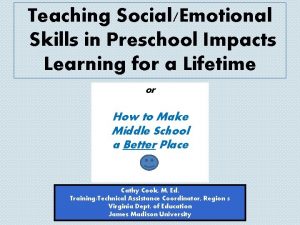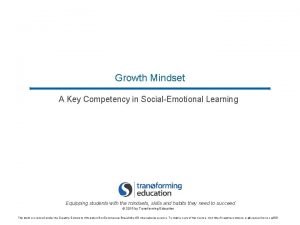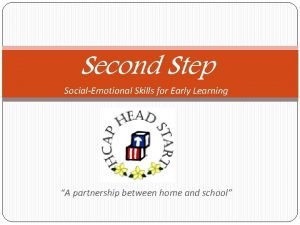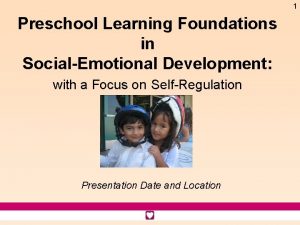SOCIALEMOTIONAL LEARNING EFFECTIVE WHOLE CLASS GROUP AND PARTNER

























- Slides: 25

SOCIAL-EMOTIONAL LEARNING: EFFECTIVE WHOLE CLASS, GROUP AND PARTNER WORK Ludlow Public Schools Ribas Associates and Publications, Inc. Consultants: Elayne Gumlaw and Nancy Athas December 7, 2018 (3 -hours)

If you need to move or take a break, please do so quietly. NORMS • Silence cell phones – step out if you must attend to a text. • Limit distractors: technology, emails, doing tasks other than what we are here to do. • If you need to take a break, do so without interrupting the learning. • Respect each other and listen when others are speaking • “All eyes up here. ” Many people cannot learn when others are off task or talking

TODAY’S OUTCOMES Social Emotional Skills in Your Practice Classroom Meeting – Community Builder “Step One”: “Downton Abbey Talk” • Explore effective whole group, small group and partner work practices through SEL • Be thinking of a priority area in your work with students: • Building consistent rules, routines and expectations for group and partner work • Supporting students in using SEL skills in their dialogue when working in groups or with a partner • Try one activity/strategy with one student or a small group of students— make it small!

Rule - 1. Respect each other. Routine- 1. Take turns when speaking. DO NOW – “ 4 -5 HEADS – ROUND ROBIN” • In a group of no smaller and no larger than 4 -5 in a group, your “role and responsibility” will be assigned by the facilitator/instructor using the following chart. Who does what? Role Responsibility Longest time in district Leader Keep group on track. All participate Least time in district Scribe Records information on chart Lives closest Time Keeper Keeps group on time Lives farthest Reporter Organizes reporting Wearing the most colors Ambassador of materials Gets materials for group

ACTIVATOR • Collaboratively, in a small group of no more than 4 to a group, make a list of things you do/strategies you use to help students work effectively in small groups or with a 3 PARTS to the Group Task: partner? Rules, Routines and SEL skills

Self-awareness Self-management Social Awareness Relationship skills Responsible decision-making The ability to accurately recognize one’s own emotions, thoughts, and values and how they influence behavior. The ability to accurately assess one’s strengths and limitations, with a well-grounded sense of confidence, optimism, and a “growth mindset. ” The ability to successfully regulate one’s emotions, thoughts, and behaviors in different situations — effectively managing stress, controlling impulses, and motivating oneself. The ability to set and work toward personal and academic goals. Social awareness The ability to take the perspective of and empathize with others, including those from diverse backgrounds and cultures. The ability to understand social and ethical norms for behavior and to recognize family, school, and community resources and supports. The ability to establish and maintain healthy and rewarding relationships with diverse individuals and groups. The ability to communicate clearly, listen well, cooperate with others, resist inappropriate social pressure, negotiate conflict constructively, and seek and offer help when needed. The ability to make constructive choices about personal behavior and social interactions based on ethical standards, safety concerns, and social norms. The realistic evaluation of consequences of various actions, and a consideration of the well-being of oneself and others. • • • • • • • Identifying emotions Accurate selfperception Recognizing strengths Self-confidence Self-efficacy Impulse control Stress management Self-discipline Self-motivation Goal-setting Organizational skills Perspective-taking Empathy Appreciating diversity Respect for others Communication Social engagement Relationship-building Teamwork Identifying problems Analyzing situations Solving problems Evaluating Reflecting Ethical responsibility

Processin g Partners: Get up and find a partner with whom you have never worked. Tas k: What is the SEL competency or skill that matches each strategy? STRATEGIES’ LOG: 1. Introduce yourself. ACADEMIC AND SEL SKILLS Strategy Purpose 4 Heads – Round Processing information Robin Direct Teach Processing Partners Whole, large group mini-lesson Processing & gaining information Notes 2. Work together so that each person contribute to the conversation. 3. Record your answers on your sheet. 4. Stay where you are.

CONNECTING SEL TO YOUR CLASSROOM AND YOUR PRACTICE Social Emotional Learning Workshop In the Classroom In Your Practice In Your Work with Students

CHAPTER 4 DEVELOPING A CLASSROOM COMMUNITY • Rules • Routines • Expectations • Group and Partner Work Routines (also Chapter 10)

Directly Teach • Rules • Routines • Expectations 10 © copyright 2017 Ribas Associates

EXAMPLE FOR CLASSROOM RULES 1. Listen respectfully when the teacher or another student is talking. 2. Raise your hand when you have something to say in class. 3. Ask permission if you would like to use another student’s or the teacher’s materials. 4. Work silently when you are doing independent work. 5. Treat everyone with the respect in which I would like to be treated. Explicitly teach and discuss (with students) rules, routines and expectations for your classroom. 11 © copyright 2017 Ribas

EXAMPLE OF CLASSROOM ROUTINES & EXPECTATIONS FOR: Student Participation __Turning in work __When and how students return assignments __Missed work Explicitly teach and discuss (with students) routines and expectations for your classroom. __Homework expectations and procedures __Moving in and out of groups __Expected behavior in group __What to do if you finish early 12 © copyright 2017 Ribas

Final Thoughts on Teaching Routines 1. Make clear what successful and unsuccessful completion looks like. 2. Test the reality of the expectations for the routine. 3. Ensure that the routine you have planned is consistent with the expectations of the school and team. 4. Create a plan for teaching the routine 5. Review routines periodically throughout the year. Turn to page 81 -82 in the RED BOOK. On an index card, write one routine that you would like to work on or improve from each category. 13 © copyright 2017 Ribas Associates

“ 11” AREAS FOR GROUP WORK 1. Alert students to transitions. 2. Group size: 2, 3, 4 students in a group. Do not exceed “ 5”. Better to start small. 3. Assign jobs. 4. Time may not be “equal” for all groups. 5. Construct tasks that student can complete independently once you’ve explained directions. 6. Set clear expectations. 7. Establish how to get assistance from the teacher. 8. Create a system for individual accountability. 9. Have procedures ready if students finish early. 10. Provide time for group share outs. 11. Provide assessment of the task and assessment of the group.

RECIPROCAL TEACHING DURING SMALLER GROUP WORK View the reciprocal teaching where each student has a different role/responsibility, and everyone takes ownership of their own learning as well as that of the group. Take notes. You will work with a “focus partner” after the video. 1. What similarities and differences do you notice between Reciprocal Teaching and “ 4 Heads Together”? 2. What did you find the most interesting about Reciprocal Teaching in this video? (Think about the role of the educator and what the students were doing. • https: //www. youtube. com/watch? v=8 o. Xskcnb 4 RA

• Agree/disagree, vote with your feet, and living likert scale activator • Academic Skills: Quick Formative Assessment, Active Participation, and Varying Perspectives GROUP WORK ACADEMIC AND SEL SKILLS FOR OLDER STUDENTS • SEL Skills: Impulse control, self-discipline, perspective-taking, respect for others, communication, social engagement, teamwork, analyzing situations, evaluating, reflecting, identifying problems, solving problems • The Routine: The facilitator asks a series of statements about a topic—for example, illegal immigration—and students are asked to indicate their level of agreement or disagreement with each statement on a scale along a wall of the class or by going to a specific corner of the class. One way in which this activator can be used to encourage wider class participation is by asking students to imagine a line cutting across the center of the classroom. Designate one side of the room as the “strongly agree” side and the other side of the room as the “strongly disagree” side. Then, read one of the statements on the activator and ask students to stand up and physically move to the spot along the invisible line that represents the strength of their opinion on the particular statement. Once students have assumed their various positions in the classroom, ask students why they feel the way they do (i. e. , why did they choose to stand in that particular spot in the classroom? ) This activity can be an effective way of generating a lively discussion and of pulling in some of our shyer students.

SAMPLE STUDENT ASSESSMENT OF PROBLEM-SOLVING SKILLS Evaluate My Problem-Solving Skills Carefully look over your corrected work and answer the questions below. 1. I used a strategy that made sense. ____yes ____no 2. I found a correct solution. ____yes ____no 3. I explained my strategy clearly and step by step. ___yes ___no 4. My score was ______. 5. Explain what you did well on this task. 6. Explain how you will improve your work in the future. p. 88

SAMPLE ASSESSMENT FORM FOR DISCUSSION GROUPS Names: Date: Group’s Discussion Topic: Circle the appropriate responses. Provide evidence wherever possible. 1. Everyone participated and shared in the discussion process. Yes No Sometimes 2. The group was supportive of its individual members. Yes No Sometimes 3. Group members often asked questions for clarification and elaboration. Yes No Sometimes 4. The group discussion stayed on topic. Yes No Sometimes Evidence: p. 88

SAMPLE ASSESSMENT FORM FOR DISCUSSION GROUPS 5. The group was energetic and enthusiastic. Yes No Sometimes Evidence: 6. What was the best thing about the way this group worked together? 7. What was one problem this group had? Did we violate any norms? 8. How did you solve it? 9. What else might you have done? 10. What specific plans do you have for improving your group’s performance the next time you meet? p. 88 - 89

“Accountable talk refers to the ways that teachers skillfully encourage their students to think deeply, articulate their reasoning, and listen with purpose. ” Cathy O’Connor, Boston University REMEMBER TO USE ACCOUNTABLE TALK WITH SMALL GROUPS OR PARTNER WORK

Accountable Talk: Elevating the Conversation in Groups (and Class)

SAMPLE SENTENCE FRAMES Agreement � “I agree with _____ because _____. ” � “I like what _____ said because _____. ” � “I agree with _____; but on the other hand, _____. ” Disagreement � “I disagree with _____ because _____. ” � “I’m not sure I agree with what _____ said because _____. ” � “I can see that _____; however, I disagree with (or can’t see) _____. ” Clarifications Which students might benefit from sentence frames? How might you teach students to use sentence frames? Give an example. � “Could you please repeat that for me? ” Sentence frames can � “I’m not sure I understood you when you said _____. Could you say more about that? ” be used to support � “What’s your evidence? ” “accountable talk”. � Paraphrase what you heard and ask, “Could you explain a bit more, please? ” � “How does that support our work/mission at _____? ”

ANCHOR CHARTS/MODELS Accountable Talk Routines • Focused, collaborative talk helps to DEEPEN and EXTEND our understanding • We always: • Make sure all voices are heard • Contribute with meaningful comments • Sit up • Look at the person talking • Nod to agree or lean in • Take turns • Be flexible • If you don’t agree, say something like, “I heard you say…. and I don’t completely agree Accountable Sentence Frames • Give credit to other’s ideas by saying, Building on …’s ideas… or I agree with what…just said about… • An Idea that I’d like to discuss is… • I was confused when I read… • I wonder if what the writer meant to say was… • When…said, it made me think of…. copyright 2018 Ribas Associates

IF TIME PERMITS, LET’S TRY RECIPROCAL TEACHING – PAGE 94 ROLE Predictor What to do… Examine the pages. Make a prediction as to the purpose of this page. Questioner Write down a question you have on the page you read. Answer the question of the questioner or questions from the group. Clarifier Summarize the important points of the page read or discussion points of the group.

SUMMARIZER • Summarizer • Next PD: January 18, 2019
 Cdc whole school whole community whole child
Cdc whole school whole community whole child Massed practice
Massed practice Cuadro comparativo entre e-learning b-learning y m-learning
Cuadro comparativo entre e-learning b-learning y m-learning Speaking and listening: effective group discussions
Speaking and listening: effective group discussions Effective group discussion theory and practice
Effective group discussion theory and practice Whole health clinical group
Whole health clinical group Making learning whole
Making learning whole Effective group discussion
Effective group discussion Bristol characteristics of effective learning
Bristol characteristics of effective learning Ros smith
Ros smith Why is summarizing important
Why is summarizing important Anova within group and between group
Anova within group and between group Voluntary group and involuntary group examples
Voluntary group and involuntary group examples Amino group and carboxyl group
Amino group and carboxyl group Amino group and carboxyl group
Amino group and carboxyl group Group 1 vs group 2 specialties
Group 1 vs group 2 specialties Joining together group theory and group skills
Joining together group theory and group skills Difference between abstract class and concrete class
Difference between abstract class and concrete class Difference between abstract class and concrete class
Difference between abstract class and concrete class Therapeutic class and pharmacologic class
Therapeutic class and pharmacologic class Static and dynamic class loading in java
Static and dynamic class loading in java Inductive vs analytical learning
Inductive vs analytical learning In analytical learning hypothesis fits
In analytical learning hypothesis fits Eager learner and lazy learner
Eager learner and lazy learner Tony wagner's seven survival skills
Tony wagner's seven survival skills Group polarization
Group polarization

